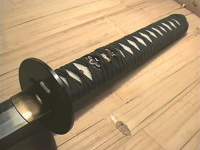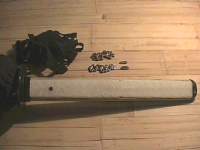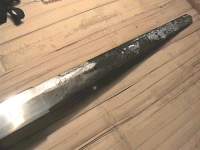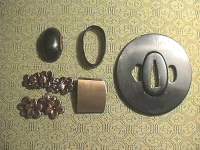The Practical Katana handle before the removal
Unfortunately the original fittings are of very bad quality.
The Fuchi is a simple steel ring; the Tsuba is a simple burnished steel
plate. The Menukis are made of plastic. The handle band is a simple
and badly wound cotton tape.
The Tsuka Ito is loosened at the Kashira.
The Kashira is a simple semicircular steel cap, whose holes are decorated
with small eyes (Shitodome). Here are these eyes already removed.
The decoiled handle.
Here you can see the Tsuka Ito, the plastic Menukis and the Shitodome.
The shape is completely even without any bend or reducing and looks therefore
very clumsy.
Detaching the Same
The fake ray skin can be removed, by warming up the clue with hot air.
Here you can also see that I have fixed the sword with a cord between
Tsuba and Saya to prevent it from slipping out of the saya.
Removing the Mekugi
Now the steel pin must be pushed away to dismantle the handle completely.
Removing the wooden handle
The fragments of the original handle after destoying...
Thereby the sword was clamped with the handle into a vice and then the
handle was split lenghtwise using a chisel.
Cleaning the tang
The Nakago has to be cleaned to remove the remaining clue. It is a full
tang with V-shaped file marks (takanoa).
You can find an illustration of the tang with measurements here.
The sword parts Fuchi, Kashira, Menuki, Tsuba and Habaki.
The black Seppa is still clued on the Tsuba and can be removed by heat.
Only the Habaki is used for the further project.







